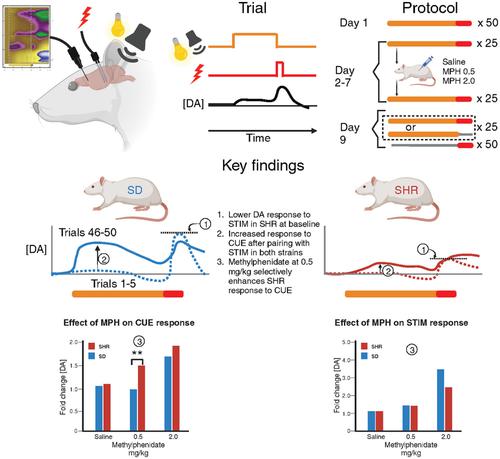当前位置:
X-MOL 学术
›
Eur. J. Nerosci.
›
论文详情
Our official English website, www.x-mol.net, welcomes your feedback! (Note: you will need to create a separate account there.)
Phasic dopamine signals are reduced in the spontaneously hypertensive rat and increased by methylphenidate
European Journal of Neroscience ( IF 3.4 ) Pub Date : 2024-02-05 , DOI: 10.1111/ejn.16269 Yu-Ting Li, Yi-Ling Huang, Jia-Jin Jason Chen, Brian Ian Hyland, Jeffery R. Wickens
European Journal of Neroscience ( IF 3.4 ) Pub Date : 2024-02-05 , DOI: 10.1111/ejn.16269 Yu-Ting Li, Yi-Ling Huang, Jia-Jin Jason Chen, Brian Ian Hyland, Jeffery R. Wickens

|
The spontaneously hypertensive rat (SHR) is a selectively bred animal strain that is frequently used to model attention-deficit hyperactivity disorder (ADHD) because of certain genetically determined behavioural characteristics. To test the hypothesis that the characteristically altered response to positive reinforcement in SHRs may be due to altered phasic dopamine response to reward, we measured phasic dopamine signals in the SHRs and Sprague Dawley (SD) rats using in vivo fast-scan cyclic voltammetry. The effects of the dopamine reuptake inhibitor, methylphenidate, on these signals were also studied. Phasic dopamine signals during the pairing of a sensory cue with electrical stimulation of midbrain dopamine neurons were significantly smaller in the SHRs than in the SD rats. Over repeated pairings, the dopamine response to the sensory cue increased, whereas the response to the electrical stimulation of dopamine neurons decreased, similarly in both strains. However, the final amplitude of the response to the sensory cue after pairing was significantly smaller in SHRs than in the SD rats. Methylphenidate increased responses to sensory cues to a significantly greater extent in the SHRs than in the SD rats, due largely to differences in the low dose effect. At a higher dose, methylphenidate increased responses to sensory cues and electrical stimulation similarly in SHRs and SD rats. The smaller dopamine responses may explain the reduced salience of reward-predicting cues previously reported in the SHR, whereas the action of methylphenidate on the cue response suggests a potential mechanism for the therapeutic effects of low-dose methylphenidate in ADHD.
中文翻译:

自发性高血压大鼠的相位多巴胺信号减少,而哌醋甲酯则增加
自发性高血压大鼠 (SHR) 是一种选择性培育的动物品系,由于某些遗传决定的行为特征,经常用于模拟注意力缺陷多动障碍 (ADHD)。为了检验 SHR 对正强化反应的特征性改变可能是由于对奖励的相位多巴胺反应改变所致的假设,我们使用体内快速扫描循环伏安法测量了 SHR 和 Sprague Dawley (SD) 大鼠的相位多巴胺信号。还研究了多巴胺再摄取抑制剂哌醋甲酯对这些信号的影响。在感觉线索与中脑多巴胺神经元电刺激配对期间,SHR 中的相位多巴胺信号明显小于 SD 大鼠。经过重复配对,多巴胺对感觉线索的反应增加,而对多巴胺神经元电刺激的反应减少,这两种菌株的情况相似。然而,配对后 SHR 对感官提示的最终反应幅度明显小于 SD 大鼠。哌醋甲酯在 SHR 中比 SD 大鼠在更大程度上增加了对感觉线索的反应,这主要是由于低剂量效应的差异。在较高剂量下,哌醋甲酯会增加 SHR 和 SD 大鼠对感觉线索和电刺激的反应。较小的多巴胺反应可能解释了先前在 SHR 中报道的奖励预测线索的显着性降低,而哌醋甲酯对线索反应的作用表明了低剂量哌甲酯治疗 ADHD 的潜在机制。
更新日期:2024-02-05
中文翻译:

自发性高血压大鼠的相位多巴胺信号减少,而哌醋甲酯则增加
自发性高血压大鼠 (SHR) 是一种选择性培育的动物品系,由于某些遗传决定的行为特征,经常用于模拟注意力缺陷多动障碍 (ADHD)。为了检验 SHR 对正强化反应的特征性改变可能是由于对奖励的相位多巴胺反应改变所致的假设,我们使用体内快速扫描循环伏安法测量了 SHR 和 Sprague Dawley (SD) 大鼠的相位多巴胺信号。还研究了多巴胺再摄取抑制剂哌醋甲酯对这些信号的影响。在感觉线索与中脑多巴胺神经元电刺激配对期间,SHR 中的相位多巴胺信号明显小于 SD 大鼠。经过重复配对,多巴胺对感觉线索的反应增加,而对多巴胺神经元电刺激的反应减少,这两种菌株的情况相似。然而,配对后 SHR 对感官提示的最终反应幅度明显小于 SD 大鼠。哌醋甲酯在 SHR 中比 SD 大鼠在更大程度上增加了对感觉线索的反应,这主要是由于低剂量效应的差异。在较高剂量下,哌醋甲酯会增加 SHR 和 SD 大鼠对感觉线索和电刺激的反应。较小的多巴胺反应可能解释了先前在 SHR 中报道的奖励预测线索的显着性降低,而哌醋甲酯对线索反应的作用表明了低剂量哌甲酯治疗 ADHD 的潜在机制。



























 京公网安备 11010802027423号
京公网安备 11010802027423号